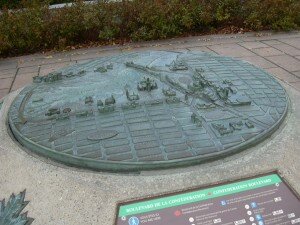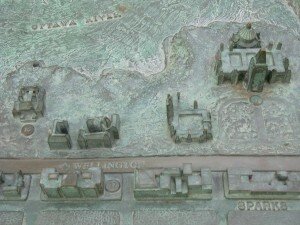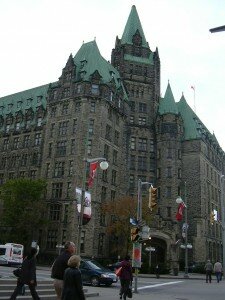From My Desk On The Hill – Committee Meetings Intro
Posted by admin on 11 Oct 2011 at 09:21 pm | Tagged as: Uncategorized

This little metal view of The Hill and environs stands on the north side of Wellington Street, east of Albert Street, a few streets west of Centre Block. The Confederation Building, which houses Elizabeth May's office, where I'm based, is just west of West Block.

The closeup shows, starting on the right, Centre Block with the Peace Tower, then West Block, then the Confederation Building's three wings.
Although she’s a Member of Parliament, Elizabeth can’t be a member of any House of Commons committees. Under current rules, only once there are a dozen Green M.P.s, will Greens be able to sit on committees. That means Elizabeth can be in the House all the time, whenever it’s in session. She quickly became very active there. Details of some of what she’s said and done in the House are on the Green Party of Canada website, greenparty.ca.
Learning about committee business is one task for her staff and volunteers. We’ve all been doing our best to attend as many committee meetings as possible.
Committees meet in various locations. Meetings I’ve attended have been in La Promenade, a government building on the Sparks Street Mall. The main Parliament buildings are on the north side of Wellington Street. Sparks is parallel to Wellington, one south; most of its length is pedestrians-only. (Gotta watch out for delivery vehicles, though.)
The Confederation Building is on the northwest corner of Wellington and Bank Streets. La Promenade is one block south and one block east, at the corner of Sparks and O’Connor Streets. Its location can be seen in the closeup above.
To be admitted to La Promenade, I show my i.d. card to the security staff in the large glass enclosure just past the entry. At least three people are usually working there, and one activates the control that opens the clear, shoulder-height doors so I can walk through. Eschewing the elevator, I climb the wide central staircase, to the second or third floor.
On the wall outside each of the three large committee rooms I’ve been in is a monitor screen, showing some details about what’s scheduled. So far, I’ve not had complete success in interpreting what I’ve read. The screen has not shown “in camera” when a meeting turned out to be so, and the three of us who’d come from Elizabeth’s office had to leave. The screen has shown “in camera” when only part of the session was such, so I’ve been able to attend the public part. Or it’s shown a meeting later in the day, rather than the one I’ve come for. More experience will help, I think.
Inside the doors is a hallway, with places to sit. The committee room is beyond more doors.
The committee chair, vice-chairs and the committee clerk sit across the front of the room, facing the others present. On their right sit the government M.P.s who are committee members; M.P.s not in the governing party sit on their left. These three groups form three sides of a rectangle. On the fourth side, facing the chair, are the visiting speakers, often government staff members.
On the table in front of each person in the rectangle is a microphone. Earphones within reach of everyone in the room amplify what’s said, but that’s not really necessary. Simultaneous translation is provided via the sound system. And those responsible for producing the report of the committee’s proceedings also rely on it; once, when it wasn’t working and all of us present could nonetheless hear just fine, the meeting had to pause for a few minutes, so the system could be fixed.
There are two rows of chairs for staff, one behind each row of M.P.s. Behind the witnesses are two tables reserved for the media. Once, there were more reporters than chairs, and one person at the front was running a camera, facing the witnesses. Other times, no media have attended.
Behind the media tables are several rows of chairs for the public. So far, at least a few of those chairs have been occupied, but there’s always been plenty of room for more visitors.
Topic examples: at a Natural Resources committee meeting, resource development in Canada’s north was discussed. And one Foreign Affairs committee meeting was a briefing update on Libya.
Witnesses make opening statements, and then respond to questions M.P.s ask. All who talk are focused and respectful – no Question Period-style antics. Every member has the chance to speak, within rigid time constraints. The chair is responsible for keeping the meeting on track. Occasionally, an M.P. takes too long. When this has happened, chairs I’ve heard so far have been polite and gentle while succeeding in being extremely firm – they are experienced politicians.
So far, I’ve taken notes by hand, on my lap, although outlets for computers are in the floor. There’s always water in pitchers, with glasses – nice not to see bottled water. Once, there were a couple of kinds of juice. And once, coffee, tea, a variety of cut-up fruit, and big, chewy cookies were available – yum.
Please keep the comments coming; more blogposts soon.
